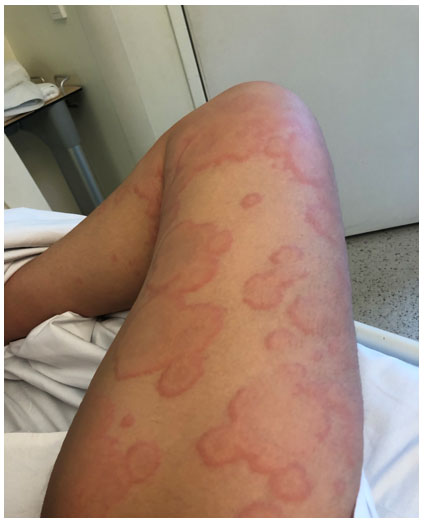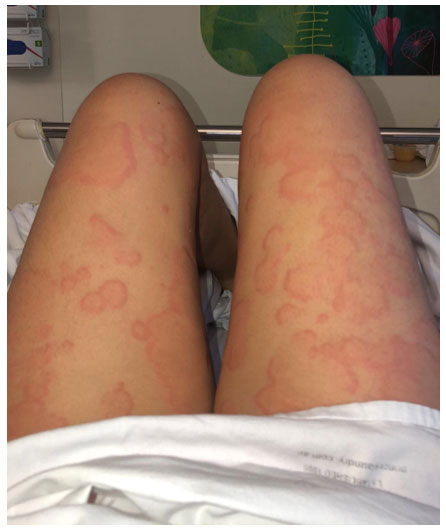See also
Urticaria
CI Esterase deficiency
Anaphylaxis
Key points
- The key features of serum sickness and serum sickness-like reactions (SSLRs) are rash, fever and polyarthritis.
- Signs and symptoms of true serum sickness occur one to two weeks after first exposure, while SSLRs usually develop after 5 to 10 days.
- Identification and removal of the causative agent is the key, but note treatment may have been ceased prior to appearance of rash.
Background
True Serum Sickness is a delayed hypersensitivity reaction, triggered by:
- Snake anti-venom, equine and rabbit anti-thymocyte globulin (ATG)
- Monoclonal antibody drugs such as Rituximab are most often implicated.
- Insect stings eg: bees
- Antiserum – rabies and tetanus
Serum Sickness-Like Reaction (SSLRs), which are more common in children, can cause a similar but less severe clinical picture, without measurable immune-complex formation. They are triggered by a variety of drugs, most commonly cefaclor and amoxicillin. Illnesses,
immunisations and occasionally chemicals can also trigger SSLRs.
Assessment
History
Explore events in the two - weeks before onset of symptoms:
- Illness
- Immunisation
- Antibiotics
- Other medication history
Explore each symptom in detail:
- Rash – children with SSLRs usually present with urticarial-type lesions (see images below), often appearing first in flexural areas and then becoming more generalised. Unlike acute urticaria, the lesions often persist for days in the same area. The rash
tends to be pruritic.
- Arthralgia – acute joint pain, limp or inability to walk.
- Fever – patients with true serum sickness develop fever >38.5. Fever may not develop in those with an SSLR, and tend to be low-grade.
Examination
- Rash – in SSLRs the skin lesions start in the flexures, but often appear more generalised.
- Lesions gradually expand, and may leave a central area of clearing or slight purpura.
- In true serum sickness the dermatologic manifestations are variable, and may include urticarial, palpable purpura, morbilliform eruptions, papules, or maculopapular lesions. Urticaria is the most common rash seen in SSLRs.
- The mucous membranes are not involved in either condition.
- Erythema and oedema of hands and feet is common
- Arthralgia is common, appearing in up to two-thirds of patients. The metacarpophalangeal, knees, wrists, ankles, and shoulder joints are most commonly involved.
- Lymphadenopathy
- Oedema – facial, periorbital and oedema of hands and feet may be seen


Differential diagnosis of serum sickness and SSLRs
- Acute viral exanthem
- Urticaria
- Systemic onset juvenile idiopathic arthritis
- Erythema multiforme*
- Stevens-Johnson syndrome*
- Kawasaki disease
- Acute rheumatic fever
* Typically show involvement of mucous membranes
| |
Rash |
Fever |
Arthralgia |
Mucous membrane involvement/ulceration |
Other systemic features |
| Serum Sickness or SSLR |
Papular, pruritic patches (hives), or morbilliform rash.
Migrate more slowly than true urticaria. |
Serum sickness – nearly always >38.5
SSLR – low-grade fever common |
Common.
Up to 2/3
Knees, wrists, ankles, shoulders, MCP joints |
No |
Lymphadeno- pathy common |
| Urticaria |
Papular, pruritic patches (hives)
Migratory |
+/- (?underlying viral illness) |
No |
No |
Mild, associated with underlying viral illness |
| Erythema Multiforme |
Symmetric, involving palms, soles, face, oral mucosa.
Typical target lesions.
Non-migratory. |
Uncommon |
Uncommon |
Yes |
Myalgia, malaise
+/-
Cough, respiratory symptoms |
| Stevens-Johnson Syndrome/TEN |
Painful vesicular or bullous lesions on an erythematous background |
Nearly always |
Common |
Yes (extensive ocular, oral and urogenital) |
Unwell. Malaise, myalgia, sore throat, photophobia / conjunctivitis |
Investigations
- SSLR is a clinical diagnosis.
- Identification of the offending agent in SSLR may be complicated if the child is on multiple medications and has a history of recent illness.
- Laboratory investigation is not necessary.
Management
- Identify and discontinue the offending drug - fever and arthralgia tends to resolve and new skin lesions stop forming within 48 hours.
- NSAIDs and/or antihistamines may be used for symptomatic treatment.
- Systemic glucocorticoids may be useful in patients with more severe symptoms and high fevers (though evidence is low)
- Once a SSLR or true serum sickness is diagnosed, the offending drug should ideally be avoided. Re-exposure may lead to a more rapid and severe serum sickness.
Consider consultation
with local paediatric team when
- If ongoing or future treatment with the offending agent is desirable – ie: treatment is lifesaving, or no suitable alternative exists – refer to clinical pharmacology or paediatric drug allergy clinic.
- For advice regarding alternative choice of antimicrobials in those children presenting with SSLR.
Consider transfer when
Child requires care beyond the comfort of the local healthcare facility
For emergency advice and paediatric or neonatal ICU transfers, call
the Paediatric Infant Perinatal Emergency Retrieval (PIPER) Service: 1300 137
650.
Consider discharge when
- Underlying diagnosis remains unclear
- Adequate symptom relief/pain control
Discharge information and follow-up
Last updated January 2019